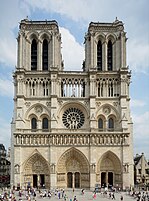Top: Notre-Dame de Paris; Salisbury Cathedral: Centre: buttresses of Cologne Cathedral, façade statuary of Chartres Cathedral; Bottom: windows of Sainte-Chapelle, Paris | |
| Years active | 12th–16th centuries |
|---|---|
Gothic cathedrals and churches are religious buildings created in Europe between the mid-12th century and the beginning of the 16th century. The cathedrals are notable particularly for their great height and their extensive use of stained glass to fill the interiors with light. They were the tallest and largest buildings of their time and the most prominent examples of Gothic architecture. The appearance of the Gothic cathedral was not only a revolution in architecture; it also introduced new forms in decoration, sculpture, and art.
Cathedrals were by definition churches where a bishop presided. Abbeys were the churches attached to monasteries. Many smaller parish churches were also built in the Gothic style. The appearance of the great cathedrals in the 12th century was a response to the dramatic increase of population and wealth in some parts of Europe and the need for larger and more imposing buildings. Technical advances, such as innovative uses of the pointed arch, rib vault and flying buttress, allowed the churches and cathedral to become much taller and stronger with larger windows and more light.[1]
The Gothic style first appeared in France at the Abbey of Saint Denis, near Paris, with the rebuilding of the ambulatory and west façade of the abbey church by the Abbot Suger (1135–40).[2] The first Gothic cathedral in France, Sens Cathedral, was begun between 1135 and 1140 and consecrated in 1164.[3]
The style quickly appeared in England, where it was called simply "The French style". The Choir of Canterbury Cathedral was destroyed by fire and was rebuilt by a French master builder from Sens, William of Sens, between 1174 and 1184. Other elements of the style were imported from Caen in Normandy by French Norman architects, who also brought finely-cut stones from Normandy for their construction.[4]
Notre Dame Cathedral was begun in 1163 and consecrated in 1177.[2] The later part of the 12th century and beginning of the 13th century saw a more refined style, High Gothic, characterised by Chartres Cathedral, Reims Cathedral, and Amiens Cathedral. A third period, called Rayonnante in France, was more highly decorated, as characterised by Sainte Chapelle (1241–1248) and Amiens Cathedral in France. The fourth and final period, called Flamboyant, appeared in the second half of the 14th century, and took its name from the flamelike motifs of decoration. Sainte-Chapelle de Vincennes (1370), with its walls of stained glass, is a good example.
Renaissance cathedrals and churches gradually replaced Gothic cathedrals, and the original cathedrals, such as Notre Dame, experienced many modifications or fell into ruin (in the Low Countries, however, the Brabantine Gothic remained until far in the 17th century). However, in the mid-19th century, in large part due to the novel Notre Dame de Paris, better known in English as The Hunchback of Notre-Dame, by Victor Hugo, there was a new wave of interest in the Gothic cathedral. Many Gothic cathedrals and churches were restored, with greater or lesser accuracy.
- ^ "gothique". Encyclopédie Larousse en ligne (in French). Retrieved 2020-07-09.
- ^ a b Renault & Lazé 2006, p. 36.
- ^ Guide, p. 153.
- ^ "Guillaume de Sens". Encyclopédie Larousse en ligne (in French). Retrieved 2020-07-09.




